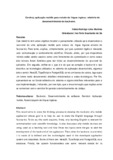| dc.creator | Martins, Fábio Rodrigo Lima | |
| dc.date.accessioned | 2023-07-18T20:29:45Z | |
| dc.date.available | 2023-07-18T20:29:45Z | |
| dc.date.issued | 2023-03-16 | |
| dc.identifier.uri | https://repositorio.ifpe.edu.br/xmlui/handle/123456789/1002 | |
| dc.description.abstract | This report aims to show the thinking process to develop the back-end of a mobile
This report aims to show the thinking process to develop the back-end of a mobile
application whose goal is to help its user to study the English language through
flashcards. To do so, this work explains, firstly, why learning English is relevant for
communication and scientific knowledge. It also discusses why mobile devices are
being used as a learning tool and how these two topics were merged to start the
development of the back-end of the application. Then, what the back-end is and what
it is made of is defined and the technologies used in the developed application
system are described. Some of them are: NestJS, TypeScript and PostgreSQL as a
database. Finally, the system functionalities and some relevant details for its
implementation are presented, indicating, for example, that the documentation that
explains how to communicate with the server was automatically generated via code. | pt_BR |
| dc.format.extent | 13f | pt_BR |
| dc.language | pt_BR | pt_BR |
| dc.relation | ABDULLAH, H; ZEKI, A; "Frontend and back-end Web Technologies in Social
Networking Sites: Facebook as an Example". In: International Conference on
Advanced Computer Science Applications and Technologies, nº 3, 2014, Amã.
Amã, 2014, p 85-89.
ALTEXSOFT. Software Documentation Types and Best Practices. 16 jan. 2018.
Disponível em:
https://blog.prototypr.io/software-documentation-types-and-best-practices-1726ca595
c7f. Acesso em: 28 fev. 2023.
BIRYUKOV, Alex; DINU, Daniel; KHOVRATOVICH, Dmitry. Argon2: new generation
of memory-hard functions for password hashing and other applications. In: 2016
IEEE European Symposium on Security and Privacy (EuroS&P). IEEE, 2016. p.
292-302.
EVANS, Eric; EVANS, Eric J. Domain-driven design: tackling complexity in the
heart of software. Addison-Wesley Professional, 2004.
FGV – FUNDAÇÃO GETÚLIO VARGAS. Retrospectiva 2021: Brasil tem dois
dispositivos digitais por habitante, revela pesquisa da FGV. 21 dez. 2021. Disponível
em:
https://portal.fgv.br/noticias/retrospectiva-2021-brasil-tem-dois-dispositivos-digitais-ha
bitante-revela-pesquisa-fgv. Acesso em: 28 fev. 2023.
HARRINGTON, Jan L. Relational database design and implementation.
Burlington: Morgan Kaufmann, 2016.
KUKULSKA-HULME, Agnes; TRAXLER, John; Mobile learning: a handbook for
educator and trainers. New York: Routledge, 2005.
MILLETT, Scott; TUNE, Nick. Patterns, principles, and practices of
domain-driven design. New York: John Wiley & Sons, 2015.
NESTJS. Modules. Disponível em: https://docs.nestjs.com/modules Acesso em: 12
de fev. de 2023.
OLUWATOSIN, Haroon Shakirat. Client-server model. In: IOSR Journal of
Computer Engineering, v. 16, n. 1, p. 67-71, 2014.
PHAM, Anh Duc. Developing back-end of a web application with NestJS
framework: Case: Integrify Oy’s student management system. Bachelor’s thesis,
2020.
Rahman, S. Why I choose NestJS over other Node JS frameworks. 20 ago. 2019.
Disponível em:
https://medium.com/monstar-lab-bangladesh-engineering/why-i-choose-nestjs-over-o
ther-node-js-frameworks-6cdbd083ae67. Acesso em: 28 fev. 2023.
REDHAT. What is an application architecture? 09 mar. 2020. Disponível em:
https://www.redhat.com/en/topics/cloud-native-apps/what-is-an-application-architectu
re. Acesso em: 28 fev. 2023.
WALLIS, John. Grammatica linguae Anglicanae. Menston: Scolar Pr., 1969. | pt_BR |
| dc.rights | Acesso Aberto | pt_BR |
| dc.rights | An error occurred on the license name. | * |
| dc.rights.uri | An error occurred getting the license - uri. | * |
| dc.subject | Desenvolvimento de software | pt_BR |
| dc.subject | Back-end | pt_BR |
| dc.subject | Servidor | pt_BR |
| dc.subject | Aplicação mobile | pt_BR |
| dc.subject | Língua inglesa- aprendizagem | pt_BR |
| dc.title | Cardery, aplicação mobile para estudo da língua inglesa: relatório de desenvolvimento do back-end. | pt_BR |
| dc.type | TCC | pt_BR |
| dc.creator.Lattes | http://lattes.cnpq.br/4376647104275729 | pt_BR |
| dc.contributor.advisor1 | Sá, Ivo Felix Gualberto de | |
| dc.contributor.advisor1Lattes | http://lattes.cnpq.br/8322686815447411 | pt_BR |
| dc.contributor.referee1 | Sá, Ivo Felix Gualberto de | |
| dc.contributor.referee2 | Carvalho, Ranieri Valença de | |
| dc.contributor.referee3 | Bandeira, Marcílio de Lima | |
| dc.contributor.referee1Lattes | http://lattes.cnpq.br/8322686815447411 | pt_BR |
| dc.contributor.referee2Lattes | http://lattes.cnpq.br/9211915276537655 | pt_BR |
| dc.contributor.referee3Lattes | http://lattes.cnpq.br/6765334070552285 | pt_BR |
| dc.publisher.department | Igarassu | pt_BR |
| dc.publisher.country | Brasil | pt_BR |
| dc.subject.cnpq | CIENCIAS EXATAS E DA TERRA::CIENCIA DA COMPUTACAO::SISTEMAS DE COMPUTACAO | pt_BR |
| dc.description.resumo | Este relatório tem como objetivo mostrar o pensamento utilizado para desenvolver oback-end de uma aplicação mobile para estudo da língua inglesa através de flashcards. Para tanto, explica, primeiramente, por que aprender inglês é relevante para comunicação e conhecimento científico. Discute, ainda, por que dispositivos móveis estão sendo usados como uma ferramenta de aprendizado e como esses dois tópicos foram fundidos para dar início ao desenvolvimento do back-end do aplicativo. Em seguida, define-se o que é e do que se compõe o back-end e são
descritas as tecnologias utilizadas no sistema da aplicação desenvolvida, algumas delas sendo: NestJS, TypeScript e PostgreSQL como um banco de dados, logo após um breve texto descrevendo detalhes relacionados a estas tecnologias. Por fim,apresentam-se as funcionalidades do sistema e alguns detalhes relevantes para a sua
implementação, indicando, por exemplo, que a documentação que explica como se comunicar com o servidor foi gerada automaticamente via código. | pt_BR |


